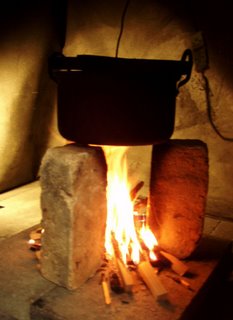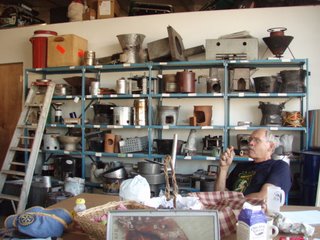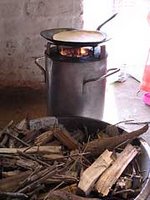Aprovecho Biomass Stove Camp 2006
 At the very last moment Susan told me about a workshop for designing and testing biomass (wood, plus other natural burnables) stoves for developing countries being held near Eugene, Oregon. No time to prepare, just enough to make the long drive there. These have been held at the Aprovecho Research Center (and sponsored by ETHOS - Engineers in Technical and Humanitarian Opportunities of Service) for the last few years (see here for photos of the last few ones http://bioenergylists.org/en/node/380 and here http://www.vrac.iastate.edu/ethos/proceedings2006.php for delightful papers from past ETHOS conferences) and efficient biomass stoves researchers gather to share information and use the excellent testing facilities. It was a fantastic opportunity to meet with international experts, hear what was going on around the world, and use world class facilities to test our local (Berkeley-LBNL-EWB) stoves - not for just fuel efficiency but also for CO, CO2, and particulate matter emissions.
At the very last moment Susan told me about a workshop for designing and testing biomass (wood, plus other natural burnables) stoves for developing countries being held near Eugene, Oregon. No time to prepare, just enough to make the long drive there. These have been held at the Aprovecho Research Center (and sponsored by ETHOS - Engineers in Technical and Humanitarian Opportunities of Service) for the last few years (see here for photos of the last few ones http://bioenergylists.org/en/node/380 and here http://www.vrac.iastate.edu/ethos/proceedings2006.php for delightful papers from past ETHOS conferences) and efficient biomass stoves researchers gather to share information and use the excellent testing facilities. It was a fantastic opportunity to meet with international experts, hear what was going on around the world, and use world class facilities to test our local (Berkeley-LBNL-EWB) stoves - not for just fuel efficiency but also for CO, CO2, and particulate matter emissions. They have tons of experience with improved cook stoves from around the world, have written some of the best books and stove design guidelines, and we could select from a huge wall of stove models to test if we wanted to. Big things are happening around the methods for testing stove designs, and a new book is coming out from Aprovecho soon that compares the most popular world stove models in areas like fuel consumption, emissions, safety, and cost. This presentation by Dean Still is a preview of what it looks like, and includes data on the VITA stove, the early predecessor of our own stove designs. They use the standard "UC Berkeley Water Boiling Test" method, plus emissions measurements, to compare stoves, and have developed new benchmarks to indicate whether a stove design is generally improved compared to a traditional primitive "three stone fire".
They have tons of experience with improved cook stoves from around the world, have written some of the best books and stove design guidelines, and we could select from a huge wall of stove models to test if we wanted to. Big things are happening around the methods for testing stove designs, and a new book is coming out from Aprovecho soon that compares the most popular world stove models in areas like fuel consumption, emissions, safety, and cost. This presentation by Dean Still is a preview of what it looks like, and includes data on the VITA stove, the early predecessor of our own stove designs. They use the standard "UC Berkeley Water Boiling Test" method, plus emissions measurements, to compare stoves, and have developed new benchmarks to indicate whether a stove design is generally improved compared to a traditional primitive "three stone fire". Global warming impacts of biomass cooking stoves (3 billion people in the world still rely on them!) was a big discussion item, and I was surprised to learn that there was a very distinct difference between the impact of burning situations like slash and burn agriculture, rain forest burning, agricultural field burning, and the emissions due to cookstoves. Controlled fires (such as stoves) produce lots of flames resulting in black carbon particulates which absorb sunlight stongly (and heat the atmosphere), while smoldering fires - may actually contribute to global cooling. Global stove emissions are thus under increasing scutiny, and initiatives to improve cookstove efficiency thriving. This is a very different reason for improving stove efficiency - for our Darfur, Sudan project we mostly consider the impact of stove fuel efficiency on human effort and security, due to the huge expediture of human effort needed to collect scarce firewood there. The cooking there is mostly outdoors so the health impacts of indoor air pollution (another reason to improve efficiency) are perhaps negligible, and global warming effects pale compare to immediate human suffering impacts.
Global warming impacts of biomass cooking stoves (3 billion people in the world still rely on them!) was a big discussion item, and I was surprised to learn that there was a very distinct difference between the impact of burning situations like slash and burn agriculture, rain forest burning, agricultural field burning, and the emissions due to cookstoves. Controlled fires (such as stoves) produce lots of flames resulting in black carbon particulates which absorb sunlight stongly (and heat the atmosphere), while smoldering fires - may actually contribute to global cooling. Global stove emissions are thus under increasing scutiny, and initiatives to improve cookstove efficiency thriving. This is a very different reason for improving stove efficiency - for our Darfur, Sudan project we mostly consider the impact of stove fuel efficiency on human effort and security, due to the huge expediture of human effort needed to collect scarce firewood there. The cooking there is mostly outdoors so the health impacts of indoor air pollution (another reason to improve efficiency) are perhaps negligible, and global warming effects pale compare to immediate human suffering impacts. The new appreciation for the potentially immense impact of biomass cook stoves on global warming and human health and security has recently resulted in concern from all kinds of different organizations - the EPA, WHO, and major oil companies at the very least - and there are numerous new initiatives to implement improved cookstoves on a global scale (millions and millions). In my opinion, there is an increased emphasis on quantitative measurements which clearly indicate impact of the improvement in the performance of new designs (both reductions in fuel consumption to accomplish specific cooking tasks, and harmful emissions which impact health and environmental impacts) - when the likes of Bill Gates, Warren Buffet, Philips, and Shell donate billions of dollars to developing world improvements they want to know ahead of time exactly what impact their efforts might have. It is widely viewed that in the past, most money spent by NGOs on international development was wasted due to inefficiencies and poor measurements - no more. This is an excellent opportunity for engineers to become involved - we more than anyone else can design improved cook stoves, measure their real impact from data collected during implementation, and predict the cumulative impact of them!
The new appreciation for the potentially immense impact of biomass cook stoves on global warming and human health and security has recently resulted in concern from all kinds of different organizations - the EPA, WHO, and major oil companies at the very least - and there are numerous new initiatives to implement improved cookstoves on a global scale (millions and millions). In my opinion, there is an increased emphasis on quantitative measurements which clearly indicate impact of the improvement in the performance of new designs (both reductions in fuel consumption to accomplish specific cooking tasks, and harmful emissions which impact health and environmental impacts) - when the likes of Bill Gates, Warren Buffet, Philips, and Shell donate billions of dollars to developing world improvements they want to know ahead of time exactly what impact their efforts might have. It is widely viewed that in the past, most money spent by NGOs on international development was wasted due to inefficiencies and poor measurements - no more. This is an excellent opportunity for engineers to become involved - we more than anyone else can design improved cook stoves, measure their real impact from data collected during implementation, and predict the cumulative impact of them!
Even if you do nothing else with this particular blog post, click here for the "big picture" of the impacts of improved cooking stoves, by the World Health Organization (WHO): http://whqlibdoc.who.int/publications/2005/9241593768_eng.pdf#search=%22UCB%20water%20boiling%20test%22. And then look briefly at the small list of key links at the bottom of the post. The theme of this year's stove camp was "fan assisted stoves" - with 50% of the world living in urban areas we can expect that locations with at least some electricity must 3 year experience living in China and SE Asia showed me that much of the terrible pollution problem there may come from all of the biomass and coal stoves that urban people use. I never considered fan stoves before, but 2 recently introduced models, see http://www.research.philips.com/newscenter/archive/2006/060227-woodstove.html and http://www.woodgas-stove.com/ for descriptions of these 2 stoves) that we tested at Aprovecho showed me that these can be incredibly efficient and non-polluting! These may not be the present, but they certainly are the future.
The theme of this year's stove camp was "fan assisted stoves" - with 50% of the world living in urban areas we can expect that locations with at least some electricity must 3 year experience living in China and SE Asia showed me that much of the terrible pollution problem there may come from all of the biomass and coal stoves that urban people use. I never considered fan stoves before, but 2 recently introduced models, see http://www.research.philips.com/newscenter/archive/2006/060227-woodstove.html and http://www.woodgas-stove.com/ for descriptions of these 2 stoves) that we tested at Aprovecho showed me that these can be incredibly efficient and non-polluting! These may not be the present, but they certainly are the future.  I believe that they are approaching the theoretical thermodymanic efficiency for both fuel combustion and heat transfer (to a cooking pot - what it takes to prepare an actual meal); speaking as a scientist, this is what we need to start to be predictive about the potential impact of better cook stoves! Fan stoves are certainly not applicable in all situations, but they may indicate benchmarks for fuel use and emissions that we can use to develop our our improved stoves - obviously, no stove can boil 5 liters of water with zero grams of fuel, but how much of the energy stored in biomass can we ultimately hope to use to cook food?
I believe that they are approaching the theoretical thermodymanic efficiency for both fuel combustion and heat transfer (to a cooking pot - what it takes to prepare an actual meal); speaking as a scientist, this is what we need to start to be predictive about the potential impact of better cook stoves! Fan stoves are certainly not applicable in all situations, but they may indicate benchmarks for fuel use and emissions that we can use to develop our our improved stoves - obviously, no stove can boil 5 liters of water with zero grams of fuel, but how much of the energy stored in biomass can we ultimately hope to use to cook food?
The human energy at stove camp was fantastic - everyone using the same stove testing method (no problem using the oversized assida pot I brought) - every surrogate testing method has its problems predicting performance in local cooking conditions, but some reliablly predictive standard test is needed that can be used by everyone to locally compare stove designs; until field tests in target countries can be conducted, as a second phase. For a description of the UCB test (+70 pages!), with comments on additional lab and field food cooking tests to demonstrate real world improvements, go to http://ehs.sph.berkeley.edu/hem/page.asp?id=42. 
The key question is whether surrogate test results can be correlated with real cooking results, so that development tests are predictive of real world results.). Biogas stoves were paticularly popular and new to me - these use lower temperatures to first just release hydrocarbon vapors from the biomass fuel, via pyrolosis, then separately burn this gas using secondary air - the burning gas can even be used alone to power cars and lanterns and such, and infinitely usable charcoal is the only "waste product"! We cooked lunch on gasifier stoves and marvelled at how clean they burned - they often required prepared fuel, wood chips or consolidated agriculatural waste; developing the infrastructure for producing such simple fuels easily and cheaply from available biomass is another project that needs engineering expertise). I tested some of our locally designed LBNL-EWB stoves (see http://darfurstoves.lbl.gov) using the UCB Water Boiling Test and it clearly distinguished between good and better stoves - this simpler test may be shorter and more reliable than our present test methods, and we should examine the differences further. Our own tests examine the impact of wind on performance, and use two different pot sizes - both are test modifiactions that reflect local Darfur cooking conditions. More work is needed to optimize our stove tests so that they are more reliable, take less time, reflect the local Darfur cooking situation, and can be used to compare our performance with that of other stoves from around the world.
I tested some of our locally designed LBNL-EWB stoves (see http://darfurstoves.lbl.gov) using the UCB Water Boiling Test and it clearly distinguished between good and better stoves - this simpler test may be shorter and more reliable than our present test methods, and we should examine the differences further. Our own tests examine the impact of wind on performance, and use two different pot sizes - both are test modifiactions that reflect local Darfur cooking conditions. More work is needed to optimize our stove tests so that they are more reliable, take less time, reflect the local Darfur cooking situation, and can be used to compare our performance with that of other stoves from around the world.
There are way too many links on the potential beneficial impacts of improved cooking stoves (both local and global), various stoves that have been developed, testing methods, and on-the-ground implementation strategies than can be easily described here - see past blog posts, and here is a simple summary of good major improved cook stove sites that will link to the rest of the information on the web:
- The UCB water boiling test - all 71 pages of it
- newsletters and more from the Partnership for Clean Indoor Air, whose purpose is to reduce the health impacts of biomass stoves (particularly by increasing efficiency).
- The always important and recently revised Design Principles for Wood Burning Cook Stoves
- My favorite stove bible Biomass Stoves: Engineering Design, Development, and Dissemination - by Baldwin - and the video of building a Baldwin style VITA stove quickly, by hand (with music)
- An excellent detailed presentation by Peter Scott, on modern stove design and performance and including implementation, presented in Uganda last year; very clear and thorough, and finally some stove performance statistics discussion!
- The Renewable Energy Policy Project (REPP) biomass stove discussion group list archives - all kinds of stove resources listed in one place. Check out their Dissemination page for all kinds of case studies, plus a great diologue on the bottom about what makes stove introduction programs work (or not work) in the real world
- Biomass Cooking Stoves list server - an additional huge mass of information, sorted into helpful categories, and links to hundreds of organizations interested in biomass stoves for developing countries (click on the Dessemination page).
No comments:
Post a Comment